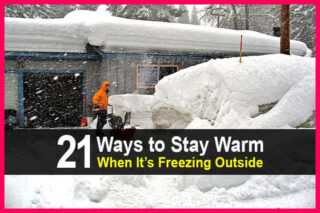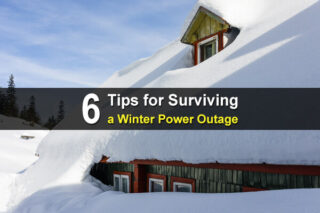Estimated reading time: 7 minutes
In case you haven't noticed, the days are getting shorter, and the nights are getting colder. And it's going to get worse before it gets better. It’s time to prepare your home for the harsh winter weather ahead.
There are three reasons to winterize your home: 1) It will keep your family nice and cozy no matter how cold it is outside. 2) If there's a power outage, it will be a lot easier to keep your family warm. 3) It will save you a ton of money. Here are 15 clever ways to winterize your home and lower your heating bill.
Want to save this post for later? Click Here to Pin It on Pinterest!
1. Inspect Your Property
The first step is to take a detailed tour of the interior and exterior of your home. Look for any ways to insulate your water supply system (both what comes in and what goes out) and check for any gaps that could cause air to seep out of your home.
2. Fill The Gaps
Warm air can leak out of your home through many openings, including doors, windows, light fittings, power sockets, and dryer vents. One of the main ways that homes lose heat is through improperly sealed ductwork.
Many leaks can be fixed with weather stripping, caulk, foam strips or expanding foam spray. You can seal large foundation cracks with mortar and then finish by applying caulk. Use plastic sheeting to cover unused windows and doors. Feel for drafts along the bottom edge of all external doors to see if you need to install, repair, or replace a draft stopper.
3. Insulate
Older homes may lack the layers of insulation that are part of modern construction. We know that warm air rises, but you can cut down on this energy loss in the winter by adding extra padding to your attic. Try chopped cellulose, which is treated to repel insects and flames.
Another way to help insulate your home is by hanging thick curtains at your windows or by insulating your windows with a window insulation kit. If your windows are a significant source of heat loss, it may be worth it to invest in energy-efficient replacements, storm windows or shutters.
Also, add some area rugs to room with hard floors. Doing this will add a layer of insulation below you as well.
4. Close Doors And Heating Vents To Unused Rooms
This simple act can redirect warm air to where you need it the most. You can shut bedroom doors during the day and open them a few hours before bedtime. Also be sure to close the air vents in those rooms. Another tip is to close closet doors to reduce the room space you are heating.
5. Close The Chimney
Your chimney lets smoke escape, yes, but it also can allow cold air in if the damper is not airtight. Masonry is costly, but you can reduce this energy vacuum this season by using fitted glass fireplace doors. You can bring more heat into a room that has a fireplace by installing an insert, a heat exchanger, or a woodstove.
Another note about chimneys. Flammable creosote can build up on chimney walls. It’s essential to clean your chimney regularly. How often you clean it depends on the amount you use the fireplace or woodstove, the type of wood you burn and its condition and other factors.
6. Reverse Ceiling Fans
If you only turn your ceiling fans on in the summer, it’s time for a change. A change of direction that is. If you look up at your fan, you should see it spinning clockwise in the summer. But in the winter, you want it to spin counter-clockwise.
By reversing the way that the fan blades rotate, you can blow the warm air that rises to the ceiling down where you can benefit from it. If you have a woodstove, you need a fan to help push the warm air throughout the house.
7. Reduce Your Water Temperature
Many water heaters are factory-set to a 140°F. By lowering the temperature by even 10°F, you can save up to five percent of your water-heating costs.
Another way to save on water heating costs is to insulate your water pipes and your heater (the type of insulation and how much of the heater should be covered depends on your type of heater). Or better yet, replace your water heater with an energy efficient on-demand system.
8. Maintain Your Furnace
Like everything else in your house, your furnace needs regular maintenance if you want it to work well and efficiently. Either hire an HVAC guy to take a look at it, or take care of it yourself. Every few months you should clean off your furnace, check the ducts for air leaks, and change the filter.
9. Be Watchful For Water Damage
Did you know that your gutters can affect your energy bills? Keeping your gutters free of debris and leaves will help prevent ice or other blockages that can cause leaks and damage to your home. Also, inspect your gutters this fall for rust or wear spots that can cause moisture to enter your home.
In addition, make sure that rain and melting snow drain away from your home. Add topsoil, contour the foundation area, or install a better drainage system as needed to keep winter wetness from entering the house.
10. Change Your Roof Color
You may want to file this one away until you need a new roof, but the color of your roof can help your home stay warm. A light-colored roof reflects sunlight and can help keep your home cooler in the summer. A dark roof absorbs heat and can help keep your home warm in the winter.
Of course, what you do depends on where you live. Which season is more of a concern for your energy bills?
11. Get a Humidifier
The cold air of winter can dry out your skin, but it helps to have a humidifier in the house. Not only will it moisten your skin, it will also make your home feel warmer. If possible, get one that's designed to work with essential oils.
12. Cook With Your Oven
No more microwave meals or room temperature snacks! From now on, cook all your meals in the oven so that its warmth will spread throughout the house. Side note: Also eat warm soup and drink hot tea. This will help you warm up fast.
13. Be Sun Savvy
Use the sun’s warmth to help heat your house. Of course, one way to do that is with solar panels. However, there is another way.
Try opening your south-facing curtains at sunrise to make the best use of this free form of solar energy. As the sun moves across the sky, close those curtains and open west-facing ones. Draw curtains and blinds at sunset to capture the heat as long as possible.
14. Move Around A Lot
When winter winds blow, it’s natural to want to huddle up and slow down. However, keeping active is a great way to stay warm. Exercise temporarily raises your body temperature. Even just staying on your feet makes a big difference.
15. Turn Down The Thermostat During The Day
Nighttime is when it gets really cold, and that's when you need your heater the most. But during the daytime, you can stay warm by using the previous two tips: using warmth from the sun and generating body heat. So go ahead and lower your thermostat and tough out the cold during the daytime. This one will lower your bill quite a bit.
To make the daytime cold more bearable, just add an extra layer of clothing and pull on a warm pair of socks. Also keep in mind that we lose most of our body heat through our heads. A comfortable beanie for each member if the family is something to consider.
Silk and wool clothing help insulate you with your own body heat, and they wick moisture away from your skin. Both materials are naturally antibacterial, soil resistant, and don’t need to be washed as often as cotton.
Bonus Tip: Make Some DIY Heaters
There are all sorts of DIY emergency heaters you can make. For example, you can make a heater from a paint can, a roll of toilet paper, and some 70% isopropyl alcohol.
As you can see, keeping your heating bill down is just a matter of being clever and resourceful.
Like this post? Don't Forget to Pin It on Pinterest!
You May Also Like:













Closing off too many heating vents will shorten the life of your furnace.